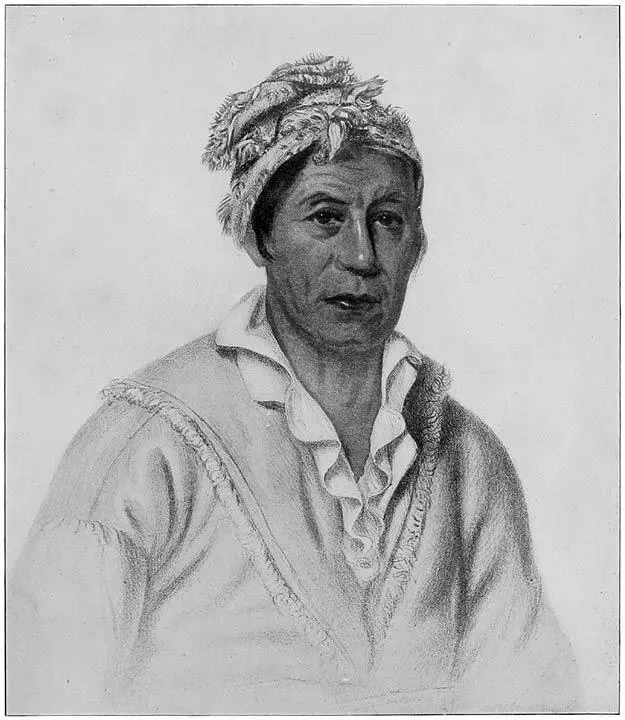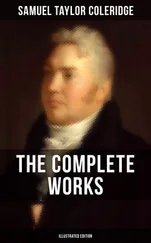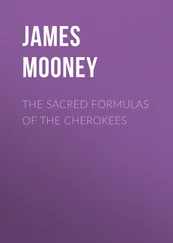The third article cancels, at the particular request of the Cherokee, that article of the treaty of 1828 by which the government was to give to the Cherokee a set of laws and a surveyor to survey lands for individuals, when so desired by the Cherokee.355

PL. VII
SPRING-FROG OR TOOANTUH (DU′TSU′)
(From McKenney and Hall’s copy of the original painting of about 1830)
Their differences with the Creeks having been thus adjusted, the Arkansas Cherokee proceeded to occupy the territory guaranteed to them, where they were joined a few years later by their expatriated kinsmen from the east. By tacit agreement some of the Creeks who had settled within the Cherokee bounds were permitted to remain. Among these were several families of Uchee—an incorporated tribe of the Creek confederacy—who had fixed their residence at the spot where the town of Tahlequah was afterward established. They remained here until swept off by smallpox some sixty years ago.356
Table of Contents
As already stated, a band of western Cherokee under Chief Bowl, dissatisfied with the delay in fulfilling the terms of the treaty of 1817, had left Arkansas and crossed Red river into Texas, then under Mexican jurisdiction, where they were joined a few years later by Tahchee and others of the western band who were opposed to the treaty of 1828. Here they united with other refugee Indians from the United States, forming together a loose confederacy known afterward as “the Cherokee and their associated bands,” consisting of Cherokee, Shawano, Delaware, Kickapoo, Quapaw, Choctaw, Biloxi, “Iawanie” (Heyowani, Yowani), “Unataqua” (Nada′ko or Anadarko, another Caddo subtribe), “Tahookatookie” (?), Alabama (a Creek subtribe), and “Cooshatta” (Koasa′ti, another Creek subtribe). The Cherokee being the largest and most important band, their chief, Bowl—known to the whites as Colonel Bowles—was regarded as the chief and principal man of them all.
The refugees settled chiefly along Angelina, Neches, and Trinity rivers in eastern Texas, where Bowl endeavored to obtain a grant of land for their use from the Mexican government. According to the Texan historians they were tacitly permitted to occupy the country and hopes were held out that a grant would be issued, but the papers had not been perfected when the Texas revolution began.357 According to the Cherokee statement the grant was actually issued and the Spanish document inclosed in a tin box was on the person of Bowl when he was killed.358 On complaint of some of the American colonists in Texas President Jackson issued a proclamation forbidding any Indians to cross the Sabine river from the United States.359
In 1826–27 a dissatisfied American colony in eastern Texas, under the leadership of Hayden Edwards, organized what was known as the “Fredonia rebellion” against the Mexican government. To secure the alliance of the Cherokee and their confederates the Americans entered into a treaty by which the Indians were guaranteed the lands occupied by them, but without specification as to boundaries. The Fredonia movement soon collapsed and nothing tangible seems to have come of the negotiations.360
In the fall of 1835 the Texan revolution began, resulting in the secession of Texas from Mexico and her establishment as an independent republic until annexed later to the United States. General Samuel Houston, a leading member of the revolutionary body, was an old friend of the Cherokee, and set forth so strongly the claims of them and their confederates that an act was passed by the convention pledging to these tribes all the lands which they had held under the Mexican government. In accordance with this act General Houston and John Forbes were appointed to hold a treaty with the Cherokee and their associated bands. They met the chiefs, including Bowl and Big-mush (Gatûñ′waʻlĭ, “Hard-mush”), of the Cherokee, at Bowl’s village on February 23, 1836, and concluded a formal treaty by which the Cherokee and their allies received a fee simple title to all the land lying “west of the San Antonio road and beginning on the west at a point where the said road crosses the river Angelina, and running up said river until it reaches the mouth of the first large creek below the great Shawnee village, emptying into the said river from the northeast, thence running with said creek to its main source and from thence a due north line to the Sabine and with said river west. Then starting where the San Antonio road crosses the Angelina and with said road to where it crosses the Neches and thence running up the east side of said river in a northwest direction.” The historian remarks that the description is somewhat vague, but is a literal transcription from the treaty.361 The territory thus assigned was about equivalent to the present Cherokee county, Texas.
The treaty provoked such general dissatisfaction among the Texans that it was not presented to the convention for ratification. General Houston became President of Texas in November, 1836, but notwithstanding all his efforts in behalf of the Cherokee, the treaty was rejected by the Texas senate in secret session on December 16, 1837.362 Texas having in the meantime achieved victorious independence was now in position to repudiate her engagements with the Indians, which she did, not only with the Cherokee, but with the Comanche and other wild tribes, which had been induced to remain neutral during the struggle on assurance of being secured in possession of their lands.
In the meantime President Houston was unremitting in his effort to secure the ratification of the Cherokee treaty, but without success. On the other hand the Cherokee were accused of various depredations, and it was asserted that they had entered into an agreement with Mexico by which they were to be secured in the territory in question on condition of assisting to drive out the Americans.363 The charge came rather late in the day, and it was evident that President Houston put no faith in it, as he still continued his efforts in behalf of the Cherokee, even so far as to order the boundary line to be run, according to the terms of the treaty (45).364
In December, 1838, Houston was succeeded as President by Mirabeau B. Lamar, who at once announced his intention to expel every Indian tribe from Texas, declaring in his inaugural message that “the sword should mark the boundaries of the republic.” At this time the Indians in eastern Texas, including the Cherokee and their twelve confederated bands and some others, were estimated at 1,800 warriors, or perhaps 8,000 persons.365
A small force of troops sent to take possession of the salt springs in the Indian country at the head of the Neches was notified by Bowl that such action would be resisted. The Indians were then informed that they must prepare to leave the country in the fall, but that they would be paid for the improvements abandoned. In the meantime the neighboring Mexicans made an effort to free themselves from Texan rule and sent overtures to the Indians to make common cause with them. This being discovered, the crisis was precipitated, and a commission consisting of General Albert Sidney Johnston (secretary of war of the republic), Vice-President Burnet, and some other officials, backed up by several regiments of troops, was sent to the Cherokee village on Angelina river to demand of the Indians that they remove at once across the border. The Indians refused and were attacked and defeated on July 15, 1839, by the Texan troops under command of General Douglas. They were pursued and a second engagement took place the next morning, resulting in the death of Bowl himself and his assistant chief Gatûñ′waʻlĭ, “Hard-mush,” and the dispersion of the Indian forces, with a loss in the two engagements of about 55 killed and 80 wounded, the Texan loss being comparatively trifling. The first fight took place at a hill close to the main Cherokee village on the Angelina, where the Indians made a stand and defended their position well for some time. The second occurred at a ravine near Neches river, where they were intercepted in their retreat. Says Thrall, “After this fight the Indians abandoned Texas, leaving their fine lands in possession of the whites.”366
Читать дальше













